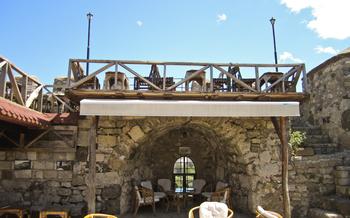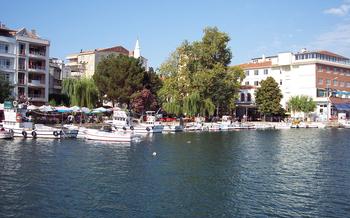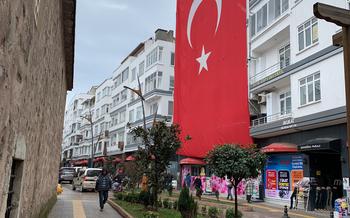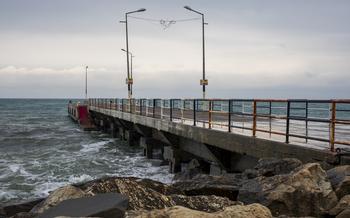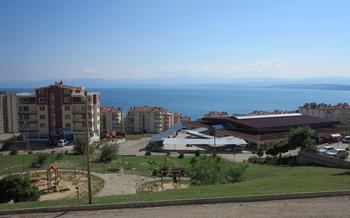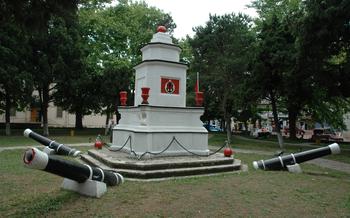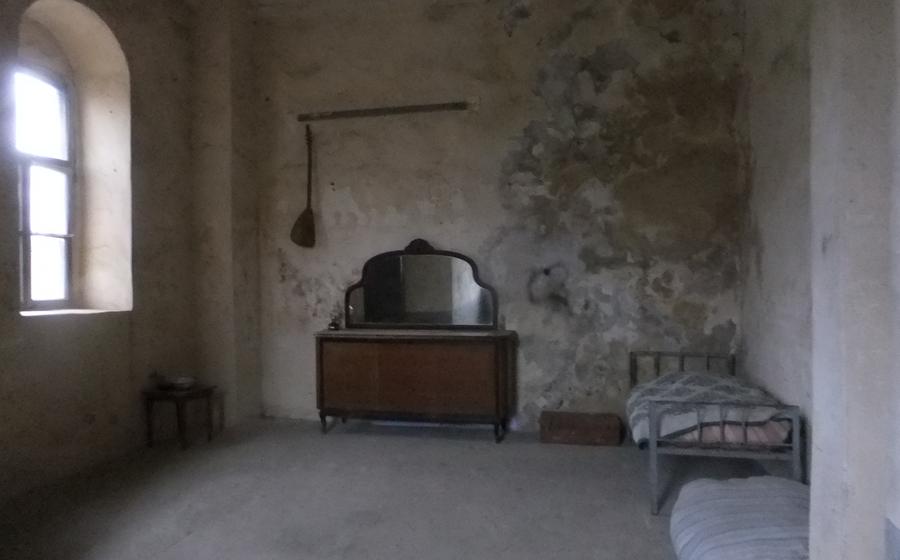
Sinop Tarihi Cezaevi
- A Glimpse of Sinop's History
- Exploring the Prison Grounds
- From Prison to Museum
- Uncovering the Stories:
- Exploring the Artifacts
- The Prison's Legacy
- A Symbol of Resilience
- A Place of Reflection
- Interactive Exhibits
- Research and Education
- Preserving the Past
- Insider Tip:
A Glimpse of Sinop's History
Along the northern shores of Turkey, where the Black Sea meets the land, lies the ancient city of Sinop. Steeped in a rich tapestry of history, Sinop boasts an array of historical treasures, including ancient ruins and prehistoric origins that speak to its enduring legacy. In the heart of this captivating city stands Sinop Tarihi Cezaevi, a former prison that once housed some of Turkey's most notorious criminals and political dissidents. The prison's imposing architecture, combined with its unique history, makes it a compelling destination for anyone seeking to delve deeper into Sinop's captivating past.
Ancient Ruins and Prehistoric Origins
Sinop's history stretches back to the mists of time, with evidence of human habitation dating back to the Neolithic period. The city's strategic location on the Black Sea coast made it a coveted prize for various civilizations throughout history, including the Greeks, Romans, and Byzantines. Each era left its mark on Sinop, resulting in a rich tapestry of architectural styles and cultural influences that can still be seen today.
Sinop as a Penal Colony
During the Ottoman Empire, Sinop gained notoriety as a penal colony, where political dissidents and common criminals were sent to serve their sentences. The harsh conditions and isolation of the prison made it a dreaded destination for those who fell afoul of the authorities. Sinop Tarihi Cezaevi, built in the late 19th century, became the primary facility for housing these prisoners.
Architectural Style and Unique Features
The prison's architectural style reflects the prevailing trends of the late Ottoman period, with a blend of neoclassical and traditional Turkish elements. The imposing stone walls, topped with crenellated turrets, convey a sense of authority and foreboding. The interior of the prison is equally striking, with its long corridors, vaulted ceilings, and rows of barred cells. The prison's unique features, such as the observation tower and the solitary confinement cells, offer a glimpse into the harsh realities of life behind bars.
Exploring the Prison Grounds
Sinop Tarihi Cezaevi was constructed in 1887 as a military prison and later served as a civilian prison until its closure in 199The prison's imposing stone walls and guard towers, reminiscent of a medieval fortress, hint at its dark past. Inside, the layout is simple yet oppressive, with cell blocks arranged in a radial pattern around a central courtyard. Each cell block consists of rows of narrow, windowless cells, designed to isolate and confine inmates. The administrative buildings, located at the heart of the prison, housed the warden's office, guards' quarters, and other administrative functions.
During its operation, the prison witnessed numerous events and stories that left an indelible mark on its history. In the early 20th century, it became a notorious place of exile for political dissidents and revolutionaries, who were subjected to harsh conditions and torture. In the 1950s, the prison gained international attention when a group of inmates staged a daring escape, using a makeshift boat to cross the Black Sea. These stories add a layer of intrigue and tragedy to the already somber atmosphere of the prison.
From Prison to Museum
The transformation of Sinop Tarihi Cezaevi from a prison to a museum was a complex and challenging process. After the prison's closure in 1999, it fell into disrepair and neglect. In 2010, the Turkish Ministry of Culture and Tourism recognized the historical and cultural significance of the site and initiated a comprehensive restoration project. The project aimed to preserve the prison's original structures and features while adapting them to their new purpose as a museum.
One of the main challenges faced during the transition was balancing the need to preserve the prison's authenticity with the need to make it accessible and welcoming to visitors. The restoration team took great care to maintain the prison's original layout and architectural details, including the cell blocks, guard towers, and administrative buildings. However, they also made modifications to improve accessibility, such as installing wheelchair ramps and elevators.
The museum's exhibits and displays were carefully curated to showcase the prison's history and the lives of its former inmates. Artifacts such as prison uniforms, tools, and personal belongings were collected and displayed to provide visitors with a glimpse into the daily lives of those who were incarcerated there. The museum also features interactive exhibits and guided tours led by former inmates, which help to bring the prison's history to life and create a more immersive experience for visitors.
Uncovering the Stories:
The stories behind the walls of Sinop Tarihi Cezaevi are as powerful as the structures themselves. Former inmates and their families have shared their personal experiences and perspectives, offering a glimpse into the lives of those who were incarcerated within these walls. These stories are not only deeply moving but also essential for understanding the human toll of mass incarceration.
One such story is that of Ahmet, a former political prisoner who spent over a decade in Sinop. He recalls the harsh conditions, the isolation, and the constant fear that permeated every aspect of life in prison. Yet, amidst the darkness, he found solace in the camaraderie of his fellow inmates and the unwavering hope that one day he would be reunited with his family.
Another story is that of Ayşe, the daughter of a former inmate. She grew up hearing stories about her father's time in prison and the struggles he faced. Through her visits to the museum, she has come to understand the depth of his suffering and the resilience he showed in the face of adversity. Ayşe's story highlights the importance of remembering the victims of mass incarceration and the impact it has on families and communities.
These personal accounts serve as a powerful reminder of the human cost of incarceration and the importance of empathy and understanding. By sharing these stories, the Sinop Tarihi Cezaevi Museum not only preserves the memory of the past but also raises awareness about human rights and social justice issues, ensuring that the struggles of those who were incarcerated here are never forgotten.
Exploring the Artifacts
At the Sinop Tarihi Cezaevi Museum, visitors can delve into the lives of former inmates through the poignant collection of artifacts on display. These relics, ranging from faded prison uniforms to well-worn tools and personal belongings, offer a tangible connection to the experiences of those who were incarcerated within these walls.
One particularly striking exhibit is a collection of handmade items crafted by inmates using limited resources. These intricate works of art, often made from repurposed materials, showcase the resilience and creativity of the prisoners. From intricate carvings to delicate embroidery, each piece tells a story of hope and determination amidst adversity.
Another highlight of the museum is the display of personal letters and diaries written by former inmates. These poignant missives provide a glimpse into the emotional toll of imprisonment, revealing the hopes, fears, and dreams of those who endured the harsh realities of prison life.
By carefully preserving and showcasing these artifacts, the Sinop Tarihi Cezaevi Museum not only sheds light on the daily lives of prisoners but also honors their experiences and sacrifices. These relics serve as a powerful reminder of the human toll of incarceration and the importance of preserving the stories of those who have been forgotten or silenced.
The Prison's Legacy
The Sinop Tarihi Cezaevi left an indelible mark on the local community, both during its operation and after its closure. During its active years, the prison's presence had a significant impact on the town's economy and social fabric. The prison provided employment for local residents, who worked as guards, administrators, and support staff. It also attracted visitors, including family members of inmates and researchers interested in the prison's history.
After the prison's closure, its legacy continued to shape the identity and culture of Sinop. The prison's imposing presence served as a constant reminder of the town's past and the struggles that had taken place within its walls. Many former inmates chose to remain in Sinop after their release, contributing their skills and experiences to the community.
In recent years, there have been growing efforts to promote reconciliation and healing related to the prison's past. The establishment of the Sinop Tarihi Cezaevi Museum has played a crucial role in this process, providing a platform for dialogue and understanding. The museum has hosted events and exhibitions that bring together former inmates, their families, and members of the local community to share their stories and experiences. Through these initiatives, the prison's legacy is being transformed from a symbol of oppression to a catalyst for healing and reconciliation.
A Symbol of Resilience
Sinop Tarihi Cezaevi has emerged as a symbol of resilience and hope, embodying the remarkable ability to overcome adversity and transform darkness into light. Stories of former inmates who have gone on to lead successful and fulfilling lives after their release serve as a testament to the enduring human spirit and the power of redemption. The prison's transformation into a museum stands as a reminder that even in the face of unimaginable hardship, there is always the potential for renewal and second chances.
A Place of Reflection
The Sinop Tarihi Cezaevi is not just a museum; it is also a place of reflection. As visitors walk through the prison's halls and cells, they are confronted with the human toll of incarceration. The somber atmosphere encourages visitors to contemplate the suffering that took place within these walls and the importance of empathy.
Ethical considerations are inherent in visiting a former prison. It is essential to remember the suffering that occurred there and to approach the experience with respect and sensitivity. The museum provides a platform for dialogue and understanding about issues related to mass incarceration and human rights, fostering a deeper appreciation for the complexities of these topics.
Interactive Exhibits
The Sinop Tarihi Cezaevi Museum features several interactive exhibits that enhance the visitor experience and bring the prison's history to life. One of the highlights is a virtual reality experience that allows visitors to step into the shoes of a former inmate and experience life behind bars. Visitors can also participate in guided tours led by former inmates, who share their personal stories and provide a unique perspective on the prison's past. These interactive elements not only make the museum more engaging and immersive but also serve as a valuable educational tool, particularly for younger visitors.
Research and Education
Sinop Tarihi Cezaevi serves as a valuable center for research and education on various topics related to penology, human rights, and social justice. The museum's extensive collection of artifacts and documents provides a rich resource for researchers exploring these fields.
Educational programs and workshops are regularly organized at the museum to facilitate learning and promote dialogue. These programs include lectures, seminars, film screenings, and guided tours led by experts in the field. The museum also collaborates with universities and research institutions to conduct joint research projects and offer internships to students.
By utilizing the prison's history as a teaching tool, the museum aims to raise awareness about the human toll of incarceration and the importance of empathy. It encourages visitors to reflect on the complexities of the criminal justice system and the need for social change.
Preserving the Past
To ensure the authenticity and historical integrity of Sinop Tarihi Cezaevi, meticulous conservation and restoration efforts have been undertaken. The original structures, including the cell blocks, guard towers, and administrative buildings, have been carefully preserved, using traditional techniques and materials to maintain their original character. The prison's interior has also been restored to reflect its former state, with attention to detail in recreating the living conditions and atmosphere of the inmates.
Striking a balance between preservation and accessibility has been a key challenge. The museum's renovation has aimed to make the prison accessible to visitors without compromising its historical integrity. Accessibility features such as ramps, elevators, and audio guides have been incorporated to ensure that everyone can experience the museum's exhibits and learn about the prison's past.
Preserving historical sites like Sinop Tarihi Cezaevi is of utmost importance for several reasons. Firstly, it allows future generations to learn about and understand the region's history and culture. The prison serves as a reminder of the struggles and suffering faced by those who were incarcerated within its walls, shedding light on a dark chapter in Turkey's past. Secondly, preserving such sites contributes to the preservation of the country's cultural heritage, ensuring that these landmarks remain accessible and appreciated by future generations.
Insider Tip:
For an unforgettable experience, plan your visit to Sinop Tarihi Cezaevi during the annual "Prisoners' Voices" event held every summer. This special event features former inmates sharing their personal stories and experiences of life behind bars, offering a unique glimpse into the human side of the prison's history. Don't miss this opportunity to connect with the past and gain a deeper understanding of the struggles faced by those who were incarcerated within these walls.
